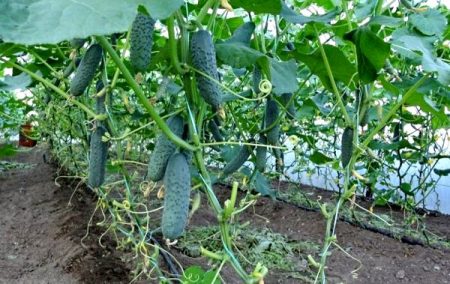 Caring for cucumbers in a greenhouse from planting to harvest is not as troublesome as an originally inexperienced gardener might seem, but, nevertheless, you need to know some nuances in order to get a good harvest.
Caring for cucumbers in a greenhouse from planting to harvest is not as troublesome as an originally inexperienced gardener might seem, but, nevertheless, you need to know some nuances in order to get a good harvest.
Initially, choosing the right seeds, soak them in warm water. While they will gain strength there to open the seeds, you prepare the soil in the boxes, do not deep holes (about 2 cm), pour them with a weak pink solution of potassium permanganate, then warm water, and then put the swollen seeds there and sprinkle with soil. When your seedlings have grown and the first leaves have appeared, you can transfer them to the greenhouse, usually there are already 5-6 leaves on the plant. Find out more cucumber care until the harvest.
Transplant to the greenhouse
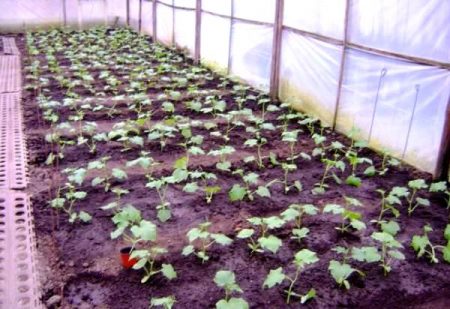
Initially, while your seedlings in the house are growing up, you need to prepare everything in the greenhouse for transplanting cucumbers to a new place. They are still tender, weak, they need to properly prepare the apartment for moving. Your soil should already be prepared in the fall - cleared of weeds and residues of harvested plants, dug up, disinfected. If cucumbers have already been grown for two years, the topsoil must be replaced by adding peat, humus and sawdust. Before planting seedlings for a week, put rotten manure into the soil, beat in pegs, pull ropes - in general, everything should be in order by the move of new residents.
Warm the prepared soil, make sure that there are no drafts, you can open the greenhouse for ventilation, there is the necessary humidity, and seedlings can be tolerated. Carefully make holes in the soil at a distance of 30-35 cm from each other, leave at least a meter between the rows, because when the bushes grow, you will not be able to walk between the rows and look after the plants. Seedlings should in no case be overexposed, no more than 25 days - and planted in a greenhouse.
The temperature in the greenhouse at night should not fall below 17 degrees, which can have the most detrimental effect on the growth of cucumbers, during the day - no higher than 30. If the humidity in the greenhouse is not high, you can shed good paths and close the greenhouse briefly to increase the moisture content inside. Avoid drafts, cucumbers are afraid of them, open the greenhouse on one side only, and remember, cucumbers love light.
Cucumber Care
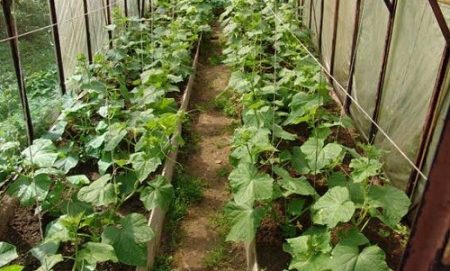
Water only with warm water, after transplanting until the ovaries appear, you can water in a couple of days, and then every day. Loosen the soil, remove weeds, tie them up, forming a bush, feed them. Mixtures of urea, superphosphate with the addition of potassium in liquid form, dissolved in water, are well suited for root dressing. For spraying, saltpeter, potassium salt diluted with water will fit in and add a little superphosphate, the dosages on the packages are detailed in detail, specify according to the area occupied by the cucumbers. When the first buds appear, reduce watering and return the buds at the beginning of flowering, which will help increase the number of female flowers and, accordingly, increase the yield.
In the first weeks, nitrogen should prevail in the fertilizing, so that the plants increase their green mass, and then remove the nitrogen, increase the amount of phosphorus. For a couple of hours before fertilizing, the beds should be shed with water, and then watered with fertilizers dissolved in water. It is better to mulch the soil.A solution of boric acid is suitable as foliar top dressing that increases the number of ovaries: 2g / 10l of water - spray in the morning early or in the evening, as there will be no heat, you can add copper sulfate and a little bit of potassium permanganate. In general, you need to monitor the plants - if they go heavily to the mass, it means a lot of nitrogen in the soil, extinguish it with phosphorus, sprinkle it with ash. If the leaves become too light with dark veins - cucumbers ask for magnesium, if yellow spots appear - you need potassium top dressing. Find out more how and with what to feed cucumbers.
Pinching cucumbers
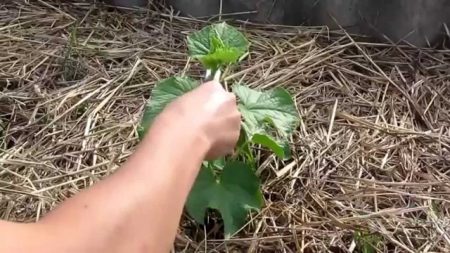
Here opinions are divided, some gardeners are firmly convinced that after the appearance of a 5-6 leaf, the main stem should be pinched so that the lateral ones develop and bloom in such a way, the latter categorically repeat - you need to let the head stem grow to a meter, and then pinch it. There is a third category that says - in the greenhouse you can generally leave one main stalk, pinching side shoots. Then, as the stem grows, lower it on a garter, wrap it around the ring, fold it, and tie it lower, making it possible to grow further than the head stem, and it will bear fruit long before the cold weather. All these statements are true, and you should try them all in your greenhouses, whichever suits you best. Each gardener has his own methods and secrets, why not use them and see what happens, and which method is more effective?
Cucumber Disease
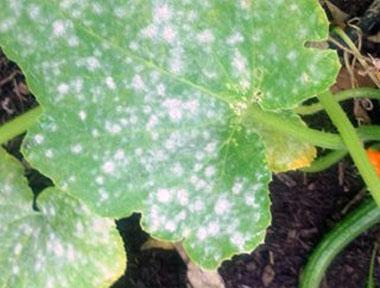
Such unpleasant disease of cucumbers as powdery mildew brings a lot of concern. The leaves begin to become covered with a whitish bloom, dry, become brittle, wither and die, the crop disappears. In order not to start the disease, you need to use the appropriate fungicides. Also, your cucumbers can be affected by uzarious wilting, requiring disinfection and soil replacement. Aphids cause a lot of trouble - if it is colonized on cucumber leaves, the crop may die. Here you can fight with folk methods - remove too burnt aphid leaves, burn them, and sprinkle the rest thoroughly with horseradish root infusion. In most cases, after 1-2 treatments, the aphid disappears. You can still put horseradish leaves and the remains of the infusion to spread under the roots of cucumbers to scare away ants that spread aphids.
But the main greenhouse disease of cucumbers can be downy mildew, called peronosporosis. Excessive humidity in the greenhouse and high temperature can provoke it. The entire crop may die from this disease. As soon as a sore is found, which manifests itself with yellowing, shrinking and drying of the leaves, an urgent need to purchase a preparation for peronosporosis and treat the plants.
Find out more as possible growing potatoes wisely without weeding and hilling.




 Armenian cucumber with melon flavor: description and characteristics, reviews
Armenian cucumber with melon flavor: description and characteristics, reviews Do-it-yourself vertical beds for cucumbers: schemes, photos
Do-it-yourself vertical beds for cucumbers: schemes, photos Hollow cucumbers: reasons for the appearance of hollow, what to do
Hollow cucumbers: reasons for the appearance of hollow, what to do Which manure is best for cucumbers: application, how to breed
Which manure is best for cucumbers: application, how to breed